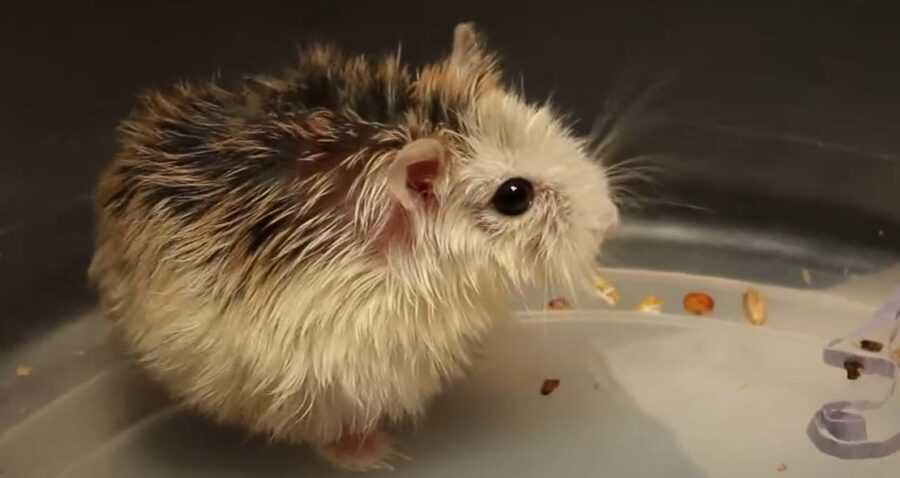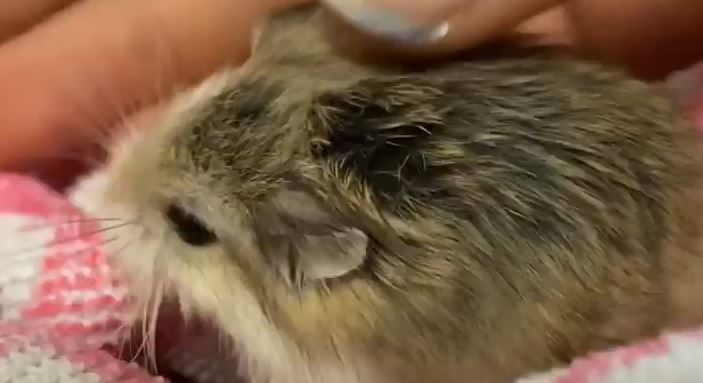When my hamster had a skin sore, I was alarmed and upset with myself. How to treat a hamster wound also requires preventive measures to make sure this doesn’t happen again or often.
What do you need to treat a hamster wound? Why do rodents get wounded easily?
In this article, we’ll look into what you can do to treat a hamster wound and how to keep your rodents and pocket pets healthy, safe and protected from future harm.
How to Treat a Hamster Wound
Your hamster’s vet will prescribe rodent safe topical ointment with antibiotics or antiseptics included. Hydrogen peroxide or iodine at the end of Q-tip could help disinfect the wound first.
You can alternatively use salt water or saline water for spot cleaning the abrasion, cut, scrape or hamster wound.
Hamsters heal rather quickly. The wound should be properly recovered and fully healed in 2 weeks time depending on the severity and location.

Is It Ok For Hamster To Lick A Wound?
Hamsters have survived for centuries on their own. This solitary rodent has encountered many close class, falls, injuries and narrow escapes from predators.
Cuts, bruises and wounds appear and heal with time. Hamsters and other rodents are accustomed to licking themselves, self-grooming and self-cleaning involving their tongues.
After dressing the wound with a topical ointment, it worries me that my hamster will want to lick it off. I learned that this cannot be avoided and shouldn’t be a major concern as long as we are using rodent safe ointments and applying only the tiniest amount.
I gently work in the cream that I place at the end of a Q-tip. By the time I have finished applying the ointment, there is no residue or moisture left to lick off. This is usually the way the product description recommended anyways.
Licking a wound for a pet hamster may help speed up their own healing and they usually do not overdo it to the point where they make the wound worse.
How Do You Treat a Hamster Infection?
An infection could be coupled with a visible wound. This is a trickier situation, because the infection is thriving and living off its rodent host.
An abscess can form that needs to be drained, lanced or removed. Antibiotics must also be administered to prevent the infection from spreading while promoting healing.
If the infected area involves an abscess that has not been ruptured, cannot be drained or it is easier to remove, a veterinarian may opt for surgery or remove it without causing extra harm for your rodent pet. Otherwise, you will be treating the area yourself with the ointment the vet provides for you.

Why Is My Hamster Wounded?
Hamsters can develop sores on their skin without you noticing or knowing why it happened. The older they get, the more sensitive their skin becomes.
The bedding, wire bars or even excess moisture from their water bottles leaving their skin damp may all have to do with hamster skin sores.
Hamsters love to rub their face and could be making it worse with self-grooming. Excessive licking of small sores can make it bigger.
- Use a topic antiseptic to treat the wounds.
- Look out for any area around the cage that may contain sharp edges.
- Make sure the exercise wheels don’t have metal rungs.
- Try a new, softer bedding material.
- Make sure your hamster is not cramped in a cage that is either too small or too full of items.
Hamsters could get clumsy and claustrophobic in an area that is too tight or cramped. Be aware and remove clutter or extend their living space so they have room to run around with a lowered chance of getting wounded.
What You Need To Clean Hamster Wounds
It’s time to stock up on supplies the next time your pet rodent gets into trouble or has an accident. Hamsters get clumsy in their cage and need your help.
Here are some items that should be available in your home to act quickly and possibly avoid a trip to the vet:
- clean towel
- Q-tips
- syringe (without the needle)
- sterile 2 x 2 gauze
- sterile saline or salt water
- disinfectant solution (Hydrogen Peroxide, Betadine or Povidone Iodine)
- Rodent safe antibiotic ointment
The ointment itself should come from the vet. They usually give you more than needed for the initial encounter and you can save the leftover for any accidents that may occur in the future.
Remember to not use ointment that has been sitting around for many years, smelling foul or the white creamy color has turned a crusty yellow or spotty brown.
Treat the area with the tiniest amount of each supply. Do not overdo the saline solution, salt water, hydrogen peroxide and ointment. This is a tiny rodent pet that only needs a gentle and miniscule amount of treatment. They will complete the job by licking themselves to promote their own healing.

When to Take Your Hamster To The Vet
Your hamster may need a vet to recover from a serious wound, injury or excessive bleeding. They will assess the damage and take a look if there is an infection or abscess that can be removed, lanced or drained.
- Dehydration may occur when a stressed hamster gives up focusing on fluids and food. A fluid injection might be necessary.
- Broken bones have to heal on their own without the use of splint that can easily be chewed off.
- Some hamsters require stitches.
- You may be advised to wrap up your hamster and pay close attention to them during the first day or two of healing.
This rodent might have a scar or limp from the injury or wound and you will both carry the memory with you to be more careful, proactive or preventative in the future.
Accidents happen however, and most of us have been where you are right now. Don’t be hard on yourself and thank you for being such a great caregiver to your beloved pock pet companion.
Thank you for visiting PocketPetCentral.com for the best information to help you enjoy the life of your pocket pet companion in a fun, safe & healthy way.

